It is regional madness to put aside the Astrazeneca vaccines. Gimbe Report
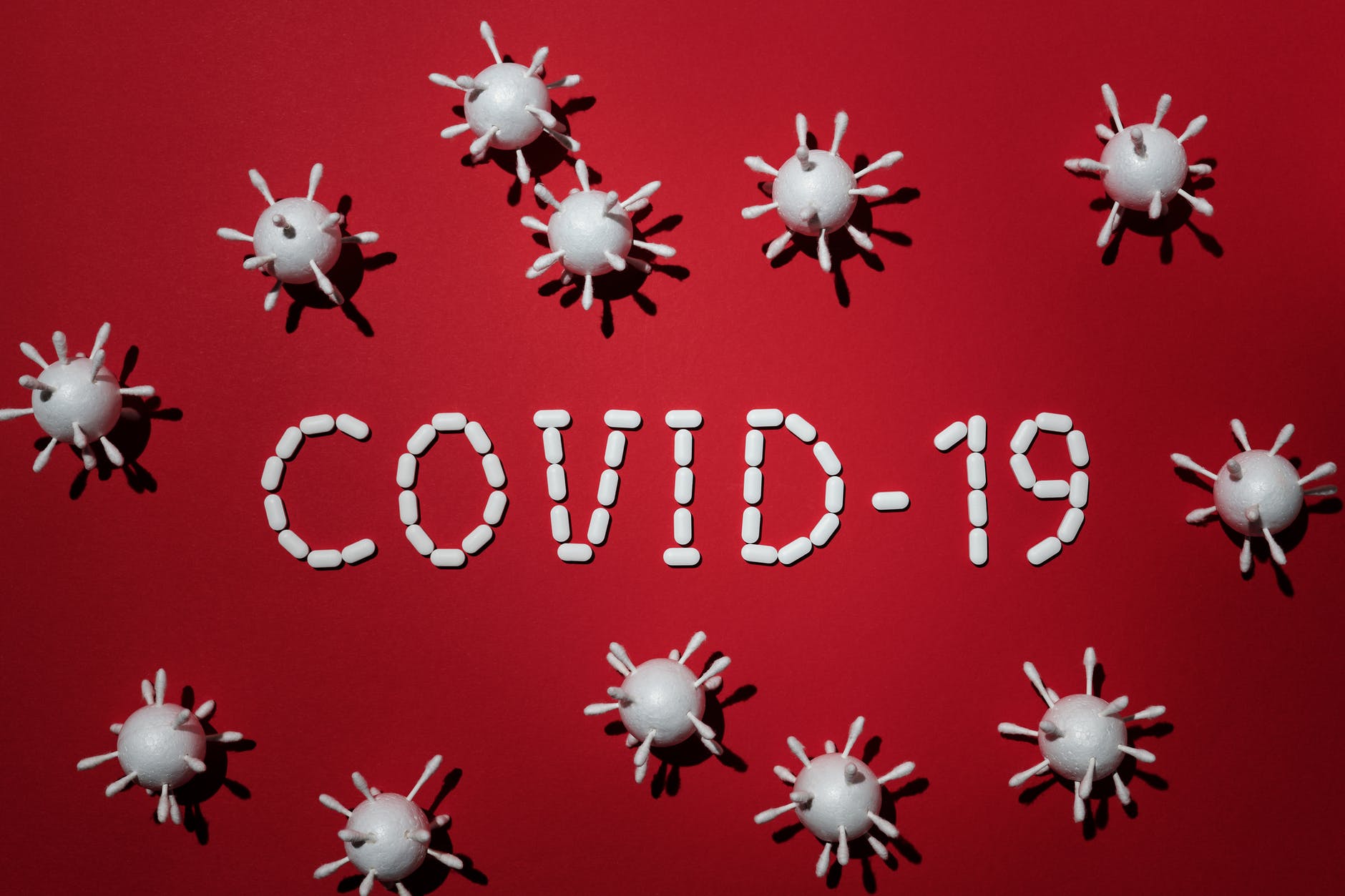
Numbers, comparisons and comments on the state of the pandemic and the vaccination campaign in the updated report of the Gimbe Foundation chaired by Nino Cartabellotta
"The vaccination campaign is struggling to take off not only due to the known delays in production and delivery of doses, but also due to organizational difficulties in many Regions that leave vaccine doses" fresh "that could avoid hospitalizations and save lives, especially among the most at risk of severe Covid-19 ".
This is what we read, among other things, in the analysis of the Gimbe Foundation chaired by Nino Cartabellotta on the state of the pandemic in Italy and on the vaccination campaign in progress.
"Unlike Pfizer and Moderna vaccines – explains Cartabellotta – for which, given the delays in supplies, it is prudent to set aside the doses for the booster scheduled respectively at 3 and 4 weeks, for AstraZeneca it is possible to administer the second dose until at 12 weeks: there is therefore no reason to set aside the doses, but instead we need to speed up the administration ».
The report of the Gimbe Foundation also comments on the first act of the Prime Minister, Mario Draghi: "The first Dpcm signed by Draghi does not at all mark the desired change of pace: the system of" color "Regions remains in fact unchanged, so such as measures for most production and commercial activities. And, as always, it is the school that pays the heaviest bill ”.
HERE'S THE FULL REPORT OF THE GIMBE FOUNDATION:
The independent monitoring of the Gimbe Foundation detects in the week 24 February-2 March 2021, compared to the previous one, a net increase in new cases (123,272 vs 92,571) (figure 1) and a modest decrease in deaths (1,940 vs 2,177) (figure 2) . Currently positive cases (430,996 vs 387,948), people in home isolation (409,099 vs 367,507), hospitalizations with symptoms (19,570 vs 18,295) and intensive care (2,327 vs 2,146) (Figure 3) are up sharply. In detail, compared to the previous week, the following changes were recorded:
- Deaths: 1,940 (-10.9%)
- Intensive care: +181 (+ 8.4%)
- Hospitalized with symptoms: +1.275 (+ 7%)
- Home isolation: +41,592 (11.3%)
- New cases: 123,272 (+ 33.2%)
- Currently positive cases: +43,048 (+ 11.1%)
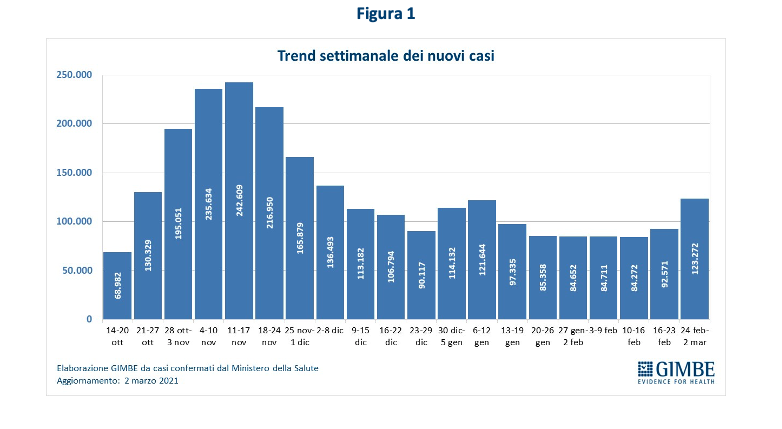
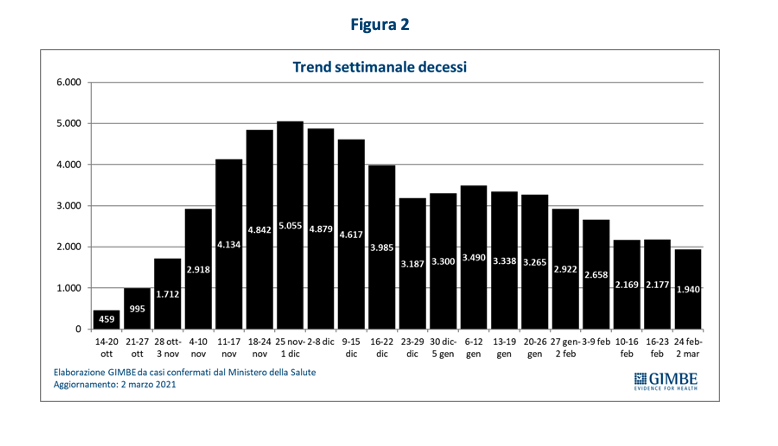
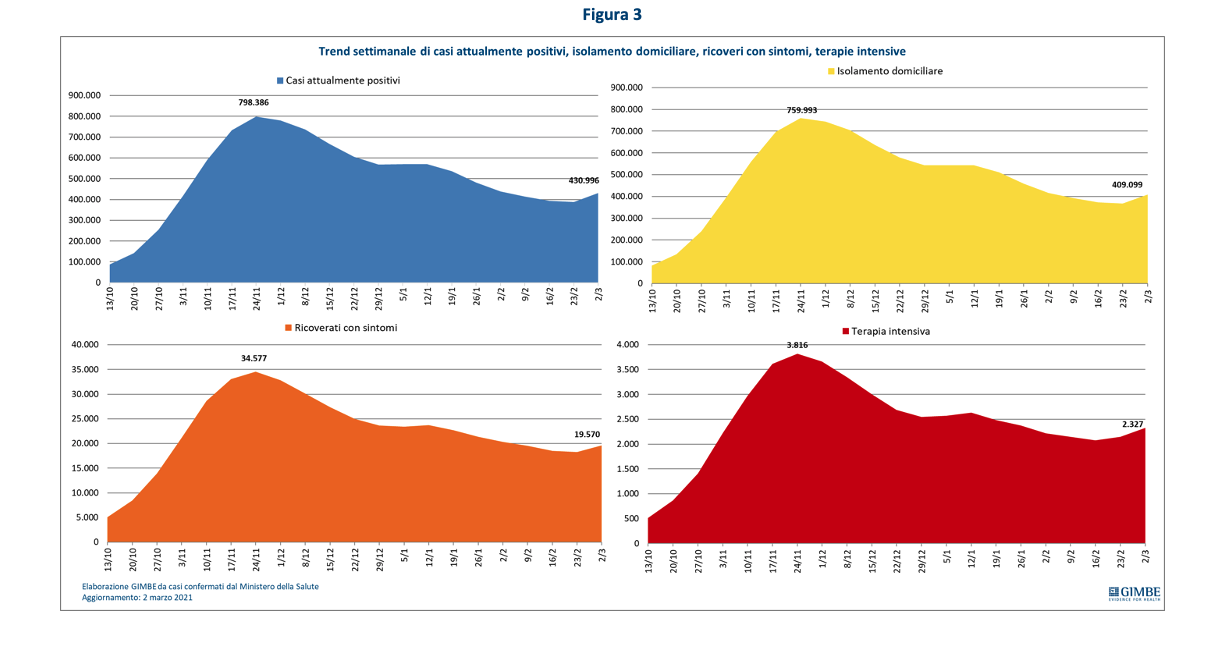
"For the second consecutive week – says Nino Cartabellotta, President of the Gimbe Foundation – there is an increase in new cases which in the last 7 days exceeds 33%, marking the beginning of the third wave". Compared to the previous week, in 16 Regions and in the PA of Trento the currently positive cases per 100,000 inhabitants increase and throughout the country the percentage increase of new cases rises with the exception of the PA of Bolzano, Umbria and Molise already subjected to severe restrictive measures (table 1). On the hospital front, employment by COVID patients in 5 regions exceeds the 40% threshold in the medical area and in 9 regions that of 30% in intensive care.
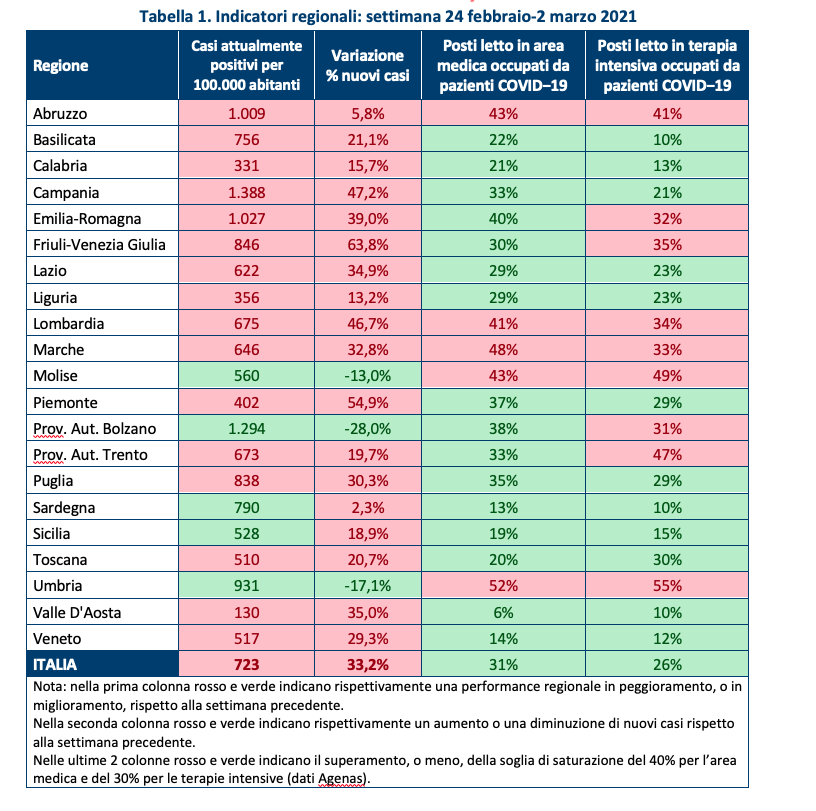
Variant control.
The survey by the Istituto Superiore di Sanità estimated, as of February 18, the prevalence of the English variant at 54% (range: 0-93.3%), of the Brazilian one at 4.3% (range: 0-36, 2%) and the South African one at 0.4% (range: 0-2.9%). "With the rapidly evolving epidemiological situation – comments Renata Gili, Head of Research on Health Services of the GIMBE Foundation – the current spread is certainly greater and it is therefore essential to be really timely in the establishment of the red zones at the municipal and provincial level".
In particular, in the week 24 February-2 March, in 94/107 Provinces (87.6%) there was a percentage increase in new cases compared to the previous week, with values that exceed 20% in 65 Provinces (table 2) . «Despite the alert launched by the Gimbe Foundation for two weeks – continues the President – the local administrators continue to delay the closures except in the face of a significant increase in new cases, when it is too late. In fact, in the presence of more contagious variants, this "non-strategy" favors the virus' run, making it necessary to more extensive and prolonged closures ».
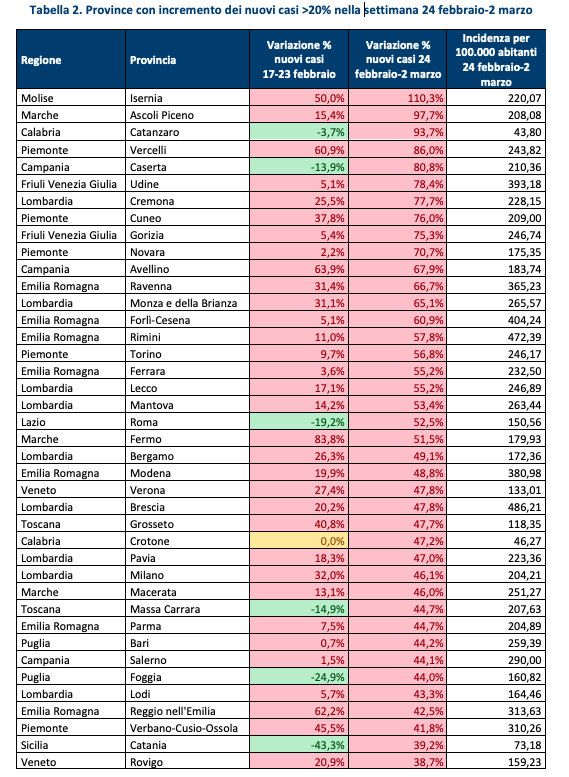
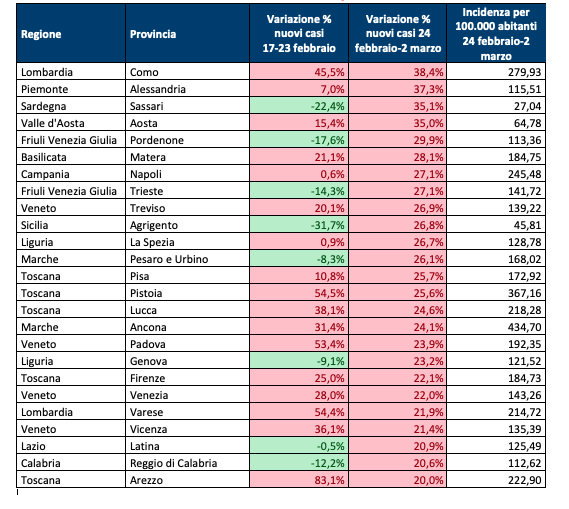
Vaccines: supplies.
Of the doses scheduled for the first quarter of 2021, 6,542,260 have been delivered to the Regions as of March 3 (update 10:17 am). This means that in order to meet the contractual deadlines set on March 31st, an average of 2.3 million doses / week will have to be delivered in the next 4 weeks. In detail:

Vaccines: administrations.
As of March 3 (update 10:17 am) 1,454,503 million people (2.44% of the population) completed the vaccination cycle with the second dose, with marked regional differences: from 4.18% of the Bolzano PA to 1.72% of Umbria (figure 4). "The start of the vaccination campaign outside hospitals and RSAs – comments Gili – has caused a slowdown on the administration front, with almost 2 million doses (equal to 30% of deliveries) still unused".
There are also significant differences between the different vaccines (figure 5): while Pfizer's administrations amounted to 89% of the doses delivered, those of Moderna and AstraZeneca are in fact proceeding more slowly. However, if 29.1% of Moderna is conditioned to the downside by the recent delivery of half the doses, for AstraZeneca the administrations amounted to 26.9%, indicating organizational problems in mass vaccination, even if possible selective waivers of this vaccine or delays in reporting data.
"Moreover, unlike the Pfizer and Moderna vaccines – explains Cartabellotta – for which, given the delays in supplies, it is prudent to set aside the doses for the booster scheduled respectively at 3 and 4 weeks, for AstraZeneca it is possible to administer the second dose up to 12 weeks: there is therefore no reason to set aside the doses, but instead we need to speed up the administration ».
Finally, compared to the protection of the most vulnerable, of the over 4.4 million over 80s, 762,271 (17.2%) received only the first dose of vaccine and only 149,620 (3.4%) completed the vaccination cycle, even here with relevant regional differences (figure 6).
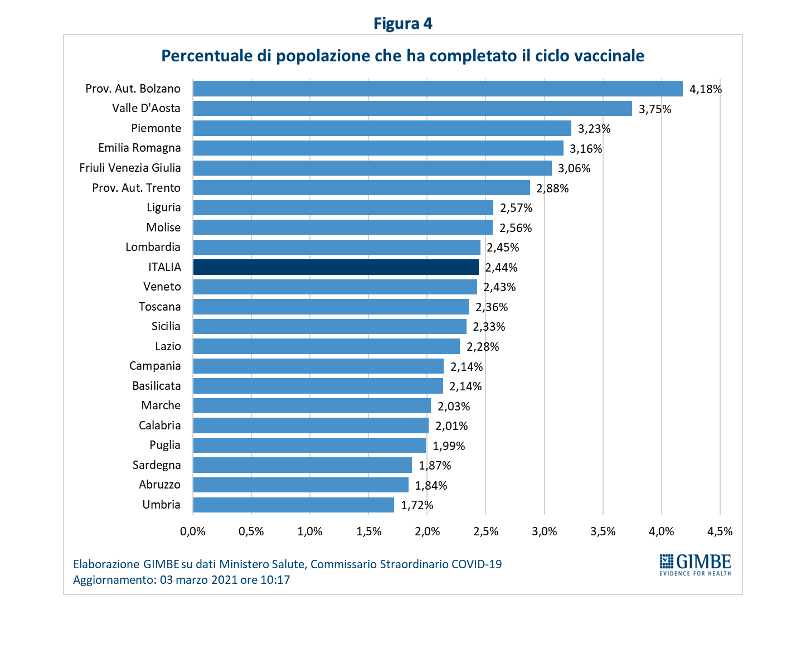
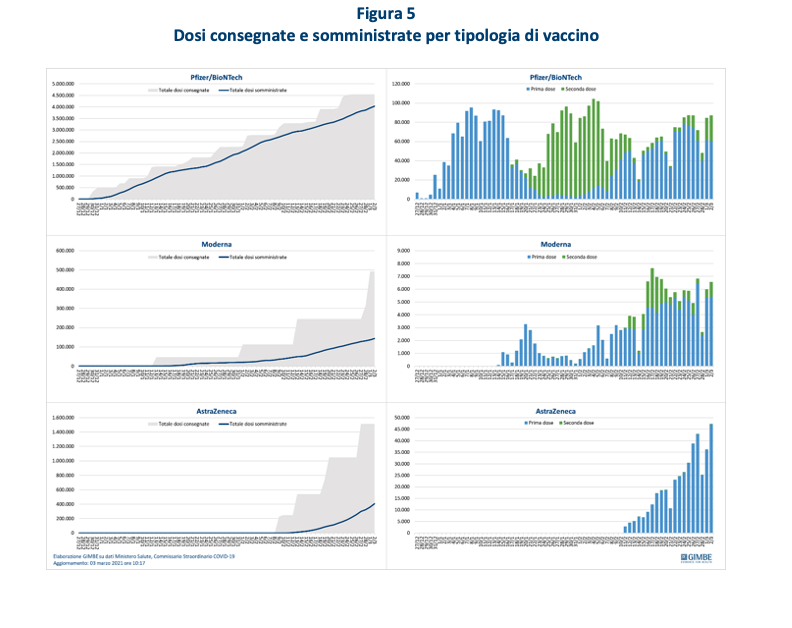
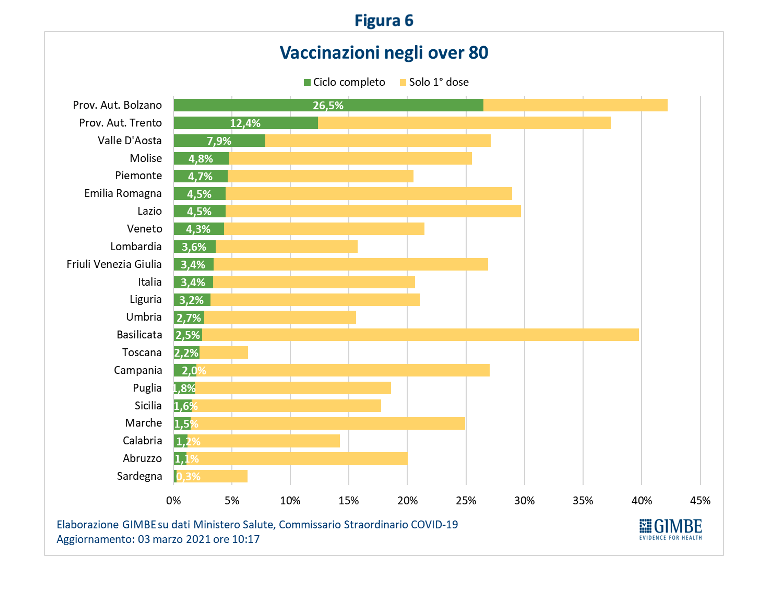
«However, the road to accelerate the vaccination campaign – the President points out – must certainly not lead to venturing into risky hazards, such as the hypothesis of administering a single dose of Pfizer or Moderna vaccine. In the absence of robust scientific evidence that would allow regulatory agencies to modify the methods of administering the product, it would be an off-label use of the vaccine, with implications for informed consent and medico-legal responsibilities ".
«The Gimbe Foundation – concludes Cartabellotta – has been signaling for weeks the red lights of an increased circulation of the virus, whose strong acceleration is in fact starting the third wave. But the times of politics and bureaucracy are always too long and the local red zones arrive when the situation has now got out of hand. Meanwhile, the vaccination campaign is struggling to take off not only due to the known delays in production and delivery of doses, but also due to organizational difficulties of many Regions that leave vaccine doses "fresh" that could avoid hospitalizations and save lives, especially among people most at risk of severe Covid-19. Finally, the first Dpcm signed by Draghi does not at all mark the desired change of pace: the system of “color” Regions remains in fact unchanged, as well as the measures for most of the production and commercial activities. And, as always, it is the school that pays the heaviest bill ».
This is a machine translation from Italian language of a post published on Start Magazine at the URL https://www.startmag.it/sanita/e-una-follia-delle-regioni-accantonare-i-vaccini-astrazeneca-report-gimbe/ on Thu, 04 Mar 2021 09:00:30 +0000.
